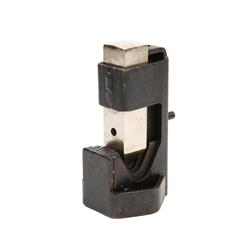Thanks for answering my question.
I have attached a picture of the inside of a outboard motor starter solenoid which would be similar to yours. This person was having problems getting his outboard to turn over and it was corrosion in the solenoid contacts.
The test you done showed "continuity" across the two main lugs on the starter when you put power to the brown/white wire and starter case. And the Bendix thru out as normal. This is good. But that doesn't mean there is good corrosion free contacts in there.
Starters by their very nature have a very high initial current draw from the power source, then it falls off sharply as the engine begins to turn.
IF the solenoid contacts are corroded and you try to pass a large current through them, the resistance goes through the roof and nothing happens or it turns very slowly. BUT when you have two fully charged batteries turned "on" you may have enough current available to overcome this resistance and the starter turns over. Corrosion in electrical systems can cause strange things to happen.
This maybe a possible explanation of what is happening.
I am just as puzzled as you why one battery wont turn that engine over, but two will.
I have attached a picture of the inside of a outboard motor starter solenoid which would be similar to yours. This person was having problems getting his outboard to turn over and it was corrosion in the solenoid contacts.
The test you done showed "continuity" across the two main lugs on the starter when you put power to the brown/white wire and starter case. And the Bendix thru out as normal. This is good. But that doesn't mean there is good corrosion free contacts in there.
Starters by their very nature have a very high initial current draw from the power source, then it falls off sharply as the engine begins to turn.
IF the solenoid contacts are corroded and you try to pass a large current through them, the resistance goes through the roof and nothing happens or it turns very slowly. BUT when you have two fully charged batteries turned "on" you may have enough current available to overcome this resistance and the starter turns over. Corrosion in electrical systems can cause strange things to happen.
This maybe a possible explanation of what is happening.
I am just as puzzled as you why one battery wont turn that engine over, but two will.


Comment